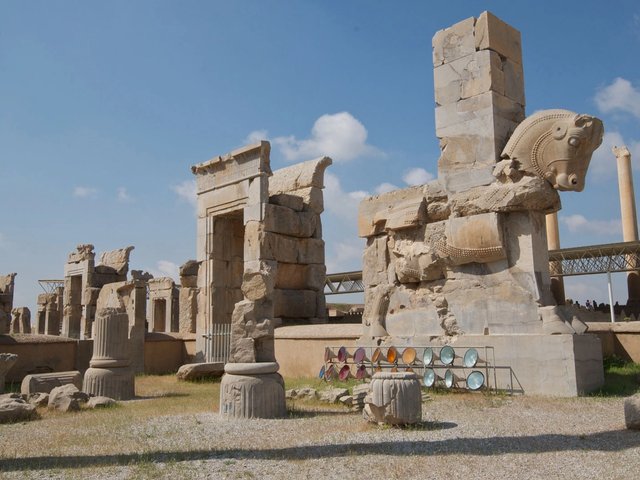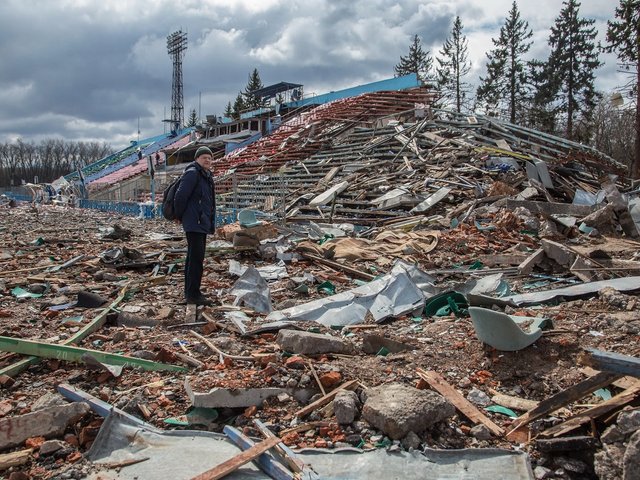Watched by millions of viewers from Los Angeles to Lahore, the sight of the hijacked airliners exploding into the twin towers of the World Trade Center on 11 September 2001 was a powerful reminder that buildings, as the most visible and potent symbols of our society, will always be prime targets in times of conflict. Muhammad Atta, one of the terrorists, was even a trained architect. This was iconoclasm on a grand scale, guided not only by religious fervour but by an understanding of an age old principle of warfare—the annihilation of cultural heritage.
In The destruction of memory: architecture at war, Robert Bevan, former editor of Building Design magazine, surveys the conflicts of the 20th century that have seen the pre-meditated destruction of architecture, demonstrating the powerful impact that this can have on the collective consciousness of communities under threat, and exploring the importance that shared memory has had in defining the way people perceive their built heritage, and how it has proved crucial in guiding responses to loss and reconstruction.
Mr Bevan points out in the introduction that an event such as Kristallnacht, the Nazi destruction of German synagogues in 1938, was almost akin to cultural genocide, an attempt “to deny a people its past as well as a future.” As he goes on to show, this was far from unique.
With its wide-ranging functional and symbolic importance in civilised society, architecture has been at the heart of mankind’s wars and conflicts since the time of the very earliest built structures. The obliteration of an enemy’s administrative buildings, places of worship, and even homes, strikes at the very core of their cultural identity. The rubble is not an end, however. The process of rebuilding is itself infused with potent meaning, whether through the restoration of an old building as a gesture of pride and defiance, or the construction of a new one as a symbol of power and subjugation.
Throughout history, churches have been built over temples, mosques over churches, and so on, in an endless cycle which has seen the creation and the destruction of some of the world’s great monuments.
The development of aviation and weapons of mass devastation in the 20th century speeded up this cycle in the maelstrom of two world wars. In more recent years, the demise of the East German Communist regime in 1989 was symbolised by the fall of the Berlin Wall which for so long had dominated the city. The wars in Iraq have focused attention on the built heritage of the “cradle of civilisation”, while in Israel and the Palestinian Authority, enforced settlement, and ultimately the erection of another segregating wall, have created even more contentious structures in a region where three religions already lay claim to many of the same sites.
In the Balkans, attempts at “ethnic cleansing” saw a co-ordinated targeting, not only of mosques and churches, but of whole communities. The Serbian shelling of the medieval port of Dubrovnik in Croatia in 1991, and the 1993 demolition of the 16th-century Ottoman bridge at Mostar in Bosnia-Herzogovina, caused international outrage at the time, and recently a number of the officers responsible have been convicted of charges relating to the destruction of cultural heritage at the International Criminal Tribunal for the former Yugoslavia (ICTY) in The Hague, in the first successful prosecutions for such crimes.
Mr Bevan takes the reader through some of the most devastating wars of the 20th century, pausing to explore how and why buildings were targeted, how communities were affected, and the issues arising from attempts to memorialise these traumatic events. In each chapter he examines the dynamics of different types of conflict. From the aerial bombing campaigns of World War II that resulted in the devastation of Dresden and the London Blitz, to sectarian struggles in Northern Ireland, Israel, and the Balkans, he uncovers the shocking statistics of various concerted attempts to eradicate the built culture of an enemy or a subjugated people.
The cultural cleansing that emerged in Bosnia had very close parallels with the Nazi obliteration of Jewish heritage, but also with the less well-known Turkish and Kurdish pogroms against the Armenians, which began in 1915 and left over 1.5 million dead and a great part of the religious architecture of one of the earliest Christian cultures reduced to rubble. In 1914, a survey by the Armenian Patriarchate of Constantinople listed 2,549 religious sites including 200 monasteries and 1,600 churches. In 1974 another survey found 914 sites remaining, including only 197 buildings in a useable state.
Nazi devastation of Jewish culture was, if anything, even more complete. In Poland almost an entire indigenous architectural tradition of 16th- and 17th-century decorative wooden synagogues was eradicated, leaving only three of these buildings standing today.
Mr Bevan’s text is brimming with detail and informed insight regarding the conflicts he covers, whether it be the attempts by Hindu zealots to erect a temple to Ram over the rubble of the demolished Babri Mosque at Ayodhya in India, the Chinese government’s eradication of the indigenous Buddhist culture from the Tibetan plateau, or the destruction by Republican nationalists of the Georgian houses of the Anglo-Irish aristocracy in Ireland during the War of Independence before 1921.
The final two chapters explore the questions of remembrance and rebuilding, protection and prosecution. The aftermath of conflict and destruction is riddled with contentious issues, and the legacy of World War II is still much in evidence across Europe. In Poland, the post-war, facsimile reconstruction of old Warsaw has been called “a Disney operation”; while Moscow, having already been rebuilt by Stalin, has seen the demolition of at least 500 historic buildings since the 1990s, as property speculation takes hold. In Germany, where the rebuilding process has generated considerable debate, the concept of Vergangenheitsbewältigung, or the mastering of the past, has informed much post-1950s reconstruction. Considerable debate still rages, however, over such issues as the fate of Nazi architecture and the appropriate ways to memorialise the Holocaust. A similar debate has entangled the fate of the site of the World Trade Center in New York, and, Bevan is highly critical of Daniel Libeskind’s winning design for the new building, calling it “an unproblematic memorial to US propaganda and false memory.”
Only thin rays of hope emerge from Bevan’s conclusion. International legislation has been ineffective, and the US and the UK are still among the few nations not to have signed the 1954 Hague Convention for the Protection of Cultural Property in the Event of Armed Conflict. China continues to dissolve the cultural identity of Tibet unhindered, while the deterrent effect of ICTY’s landmark prosecutions of cultural war crimes remains to be seen. Mr Bevan proposes an amendment of the United Nations 1948 Genocide Convention to include a specific charge of “cultural genocide”, to be administered by a permanent International Criminal Court. In the face of the destruction he has just catalogued in this excellent book, however, it seems unlikely that international law will ever fully curtail mankind’s proclivity to use such enduring tactics of terror.
Originally appeared in The Art Newspaper as ‘Architectural destruction as genocide'



